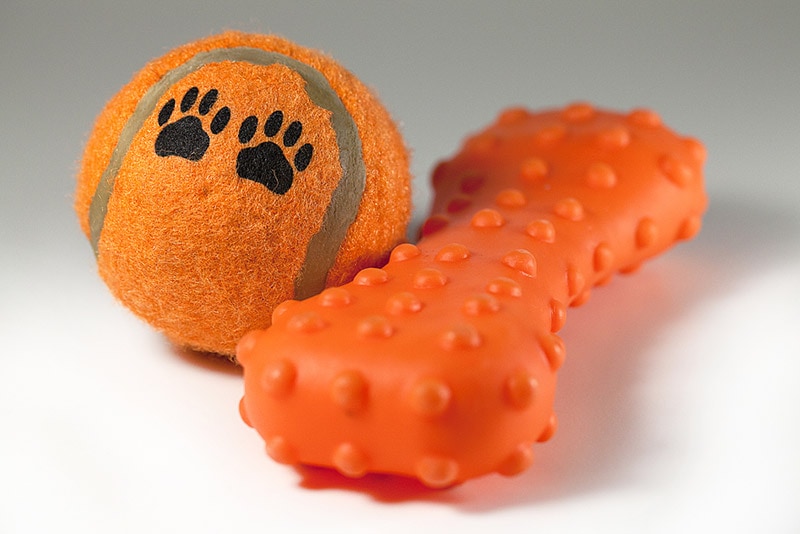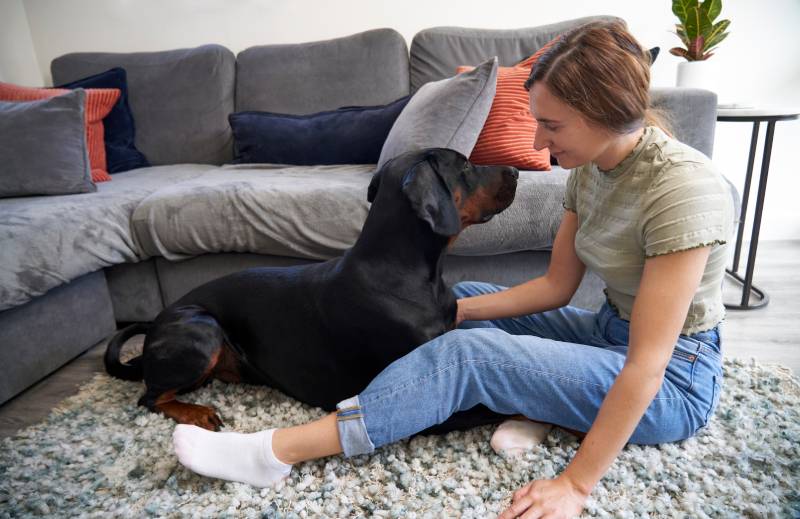How to Crate Train a Doberman – 9 Tips & Tricks
Updated on

Doberman Pinschers are intelligent and loyal dogs. They will protect their humans to the fullest! For first-time Dobie owners, you may be wondering how to crate-train. Mixed feelings surround the topic of crate training your Dobie, but in our opinion, crate training is a wonderful tool to help your Dobie feel safe and secure; you just need to know how to go about the process.
In this article, we’ll explain nine tips and tricks to ensure crate-training success for your Dobie.
Before You Start
First of all, we want to stress that crate training should never be used as a punishment but rather as a place of peace, quiet, sleep, and relaxation.
Another important factor before you start is to buy the correct sized crate for your Dobie. As a general rule, the crate should be roughly 3 to 4 inches longer than your Dobie’s body. You don’t want the crate too big because your Dobie may relieve himself inside. You also don’t want it too small because it needs to be comfortable for your Dobie. For those with Dobie puppies, you’ll need to buy a bigger crate as your Dobie grows.
Secondly, ensure you place blankets or a comfy crate bed for your Dobie inside the crate.
Lastly, ensure you have plenty of your Dobie’s favorite treats handy before starting the crate training process. Now, let’s get down to business.
How to Crate Train a Doberman
1. Placing the Crate
The crate’s location is important, but the ideal location may vary depending on your Dobie’s age. For example, if your Dobie is a puppy, you’ll want to place the crate beside your bed for sleep at night. The reason is that puppies cannot hold their bladders for longer than 3 to 4 hours at a time, and you’ll be able to hear your Dobie better when he needs to go potty in the middle of the night.
For older Dobies, place the crate in a quiet and peaceful place, with the back of the crate up against the wall and the crate door facing the room’s exit. The crate should be a place of refuge. If you have children, teach them not to bother the dog; this teaches your Dobie that the crate is a safe place he can go for peace and quiet.

2. Throw a Treat Inside
As we’ve mentioned, ensure you have plenty of treats on-hand for this process. The idea is to get your Dobie inside the crate. The treat should distract him long enough to not be bothered by the confinements of the crate. Once your Dobie is inside, let him eat the treat and leave the door open. After he’s done, you can allow him to exit freely. Remember to praise him after eating the treat.
3. Throw Another Treat and Block the Exit
This step is simply repeating throwing a treat inside the crate, only this time, crowd the exit a bit while your Dobie eats the treat. You want to block the exit just enough to where your Dobie cannot exit. After he’s eaten the treat, let him out. You can repeat this process a few times.
Tip: If your Dobie is not interested in the treats, you can always try feeding your Dobie inside the crate and letting him out after he’s finished. Place the food bowl toward the back of the crate to entice him to enter. Keep the door closed while he’s eating, and open the door after he’s done.

4. Find a Command Word of Phrase
Dobies are super smart and can learn up to 250 words of the human language. With that said, your Dobie will have no problem learning commands, but it’s vital that you pick a command and stick with it for training purposes. For instance, use appropriate commands, such as kennel up, go to your crate, crate, or whatever you feel is fitting. Whatever word or phrase you land on, stick with it!
5. Close the Crate Door
Once you’ve repeated the process of having your Dobie eat treats or his food inside the crate, shut the door to the crate but remain in the room. Leave your Dobie inside for a good couple of minutes each time you practice this process. By staying in the room, your Dobie can see you, and it should eliminate any anxiety or stress.

6. Build Up Time Inside the Crate
The goal here is to gradually increase the time your Dobie is inside the crate. As time goes by, your Dobie should become more and more comfortable. If your Dobie is reluctant to go inside the crate, try playing with him to get him tired; that way, he’ll probably be more prone to go inside for a quick nap.
7. Place Toys Inside the Crate
Placing safe toys inside the crate is an excellent way to distract your Dobie while inside. Dog puzzles are a superb way to keep your Dobie distracted, and it’s safer than some type of chew toy your Dobie can destroy in minutes or get choked on.

8. Leave the Room
Once your Dobie is inside the crate, and he’s gone potty and been fed, leave him for a few minutes. He may bark, but don’t come to the rescue! Let him whine until he stops for a long pause. You can then re-enter the room, let him out, and praise him. You don’t want your Dobie to associate whining with being let out of the crate. You want your Dobie to learn that the crate is not a bad place.
9. Repeat, Repeat, Repeat
Repetition is key in crate training, and you’ll want to repeat all the steps mentioned until your Dobie is comfortable with going into the crate. Once your Dobie seems comfortable going inside, and you feel he’s trained, leave the crate door open during the day so he can come and go freely.
Tip: Some Dobies take to crate training faster than others, and you must remain patient during the entire crate training process. Don’t get discouraged; with patience and time, your Dobie will get the hang of it. Never force your Dobie inside the crate, especially after a bad or stressful event, and never place your head inside the crate; if your Dobie is stressed, he may bite.

Conclusion
Crate training your Dobie is an excellent idea to give him a safe and secure place to rest or sleep. Having your Dobie crate trained is also an excellent way to keep him out of any potentially threatening events, such as young children coming over or needing to put him away in case another dog comes over, etc.
The crate should be a place of refuge, and never use the crate as a form of punishment. If you still have trouble, you can always hire a professional trainer to ensure crate-training success. Remember that Dobies are incredibly smart, and your Dobie can learn to go inside the crate without issues over time.
Featured Image Credit: Parilov, Shutterstock













